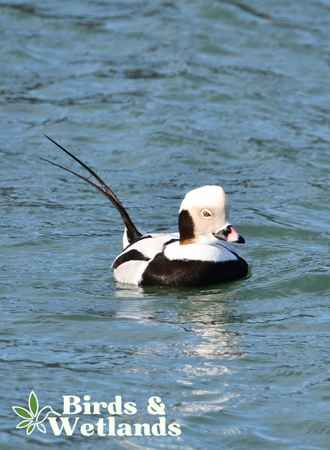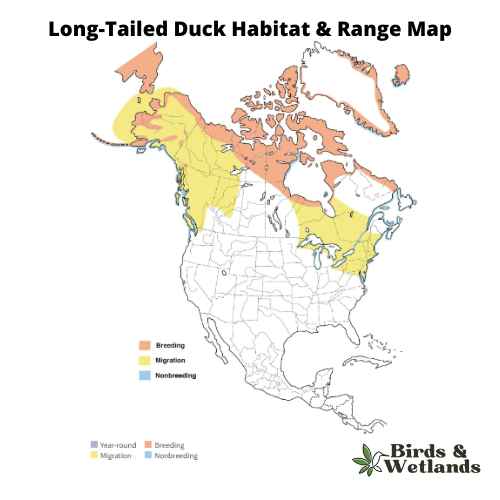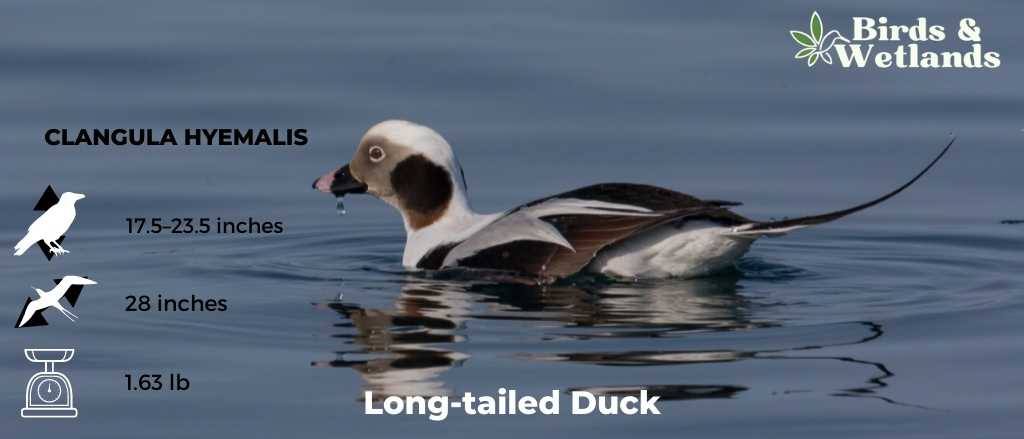The Long-tailed duck (Clangula hyemalis) is a brightly-plumaged sea duck breeding in northern parts of Europe and Asia and wintering in coastal waters in the southern parts of the Atlantic and Pacific oceans. It was previously called oldsquaw and is often the most abundant bird in the high Arctic.
As the only member of the genus Clanugula, it is monotypic. The genus has no subspecies.
In appearance, the long-tailed duck is easily recognizable by its distinctive long pointed tail feathers, which give the species its name.
Scientific Name: Clangula hyemalis
Length: 440–600 mm (17.5–23.5 in)
Wingspan: 710 mm (28 in)
Weight: 740 g (1.63 lb)
Physical Description
The adult female long-tailed duck is easily recognizable by its dark crown and white throat. It has a black and brown mottled back, breast and belly. Its wings are black with white specks and a small bill.
The adult male long-tailed duck has dark wings, a black head, a white face patch, a white patch around the eye, white underparts and a gray face.
Juvenile males have a gray cheek patch, a white head and a pink band on the bill. They have the reverse pattern of the breeding plumage of the adult male.

Listen to the Long-tailed Duck
Habitat & Geographic Range
Dense concentrations and large flocks of long-tailed ducks are found in their natural breeding habitat, which includes marshes and tundra pools. Their preferred habitats vary depending on the season, but they require open waters near shallow marshes or wetlands to forage for aquatic plants and insects.
Additionally, most ducks need forests and nearby meadows that provide shelter from storms, protection from predators, and suitable conditions for nesting and raising their young.
The long-tailed duck typically breeds in tundra areas near coastal water sources and slow rivers.
In winter, long-tailed ducks are commonly found in coastal waters but may also be seen on low-lying tundra, hilly regions, and near forest edges. Some flocks travel to the Great Lakes, the Pacific Coast and the west coast of the Bering Sea.
Although an uncommon migrant, some birds may wander off in central and southern parts of the United States.

Behavior & Diet
The long-tailed duck is an omnivorous species that varies its diet according to the season. But most feeding is done on or under the water.
During other seasons, it primarily feeds on aquatic insects such as flies and beetles, crustaceans including shrimp, crabs and amphipods, mollusks like mussels, clams and periwinkles, and fish eggs.
In the winter, it feeds on mussels, small fish and aquatic invertebrates in open ocean waters and large lakes.
Long-tailed ducks can dive up to a depth of 55 meters, deeper than any other duck.

Nesting & Mating Habits
Pairs generally form in early spring. The long-tailed duck is a ground-nesting species that builds its nests on dry ground close to water sources. The female builds a shallow depression lined with dark down and plant material to camouflage her eggs from predators.
She has brown plumage, which makes her nearly invisible on the ground, and lays between 5-9 pale green eggs, which she incubates alone for 24-29 days. When the young hatch, they follow their mother to the nearest freshwater pond to learn how to swim and hunt for food.
After about 35-40 days, the young fledge and become independent of their parents but may stay together in small flocks until the next breeding season, when they will disperse to find new nesting grounds.

Threats & Conservation
The long-tailed duck faces numerous threats to its survival, primarily due to oil spills, hunting and human activity in the northern seas. Hunting has reduced the number of birds wintering in the Baltic Sea, and they are also highly susceptible to being trapped in fishing nets.
In addition, their habitats are threatened by increasing urbanization, commercial development, pollution and climate change.
Hunting
In the right season, it’s possible to hunt long-tailed ducks in Alaska. Regulations differ between seasons and zones, so to be successful, hunters should familiarize themselves with the current laws governing hunting long-tailed ducks before they go out.

Key Points
- The female has a relatively short pointed tail compared to the male.
- Females and non-breeding males have a dark cheek patch.
- This duck species is named after its long tail.
- Long-tailed ducks are expert divers that can dive deeper than other ducks.


